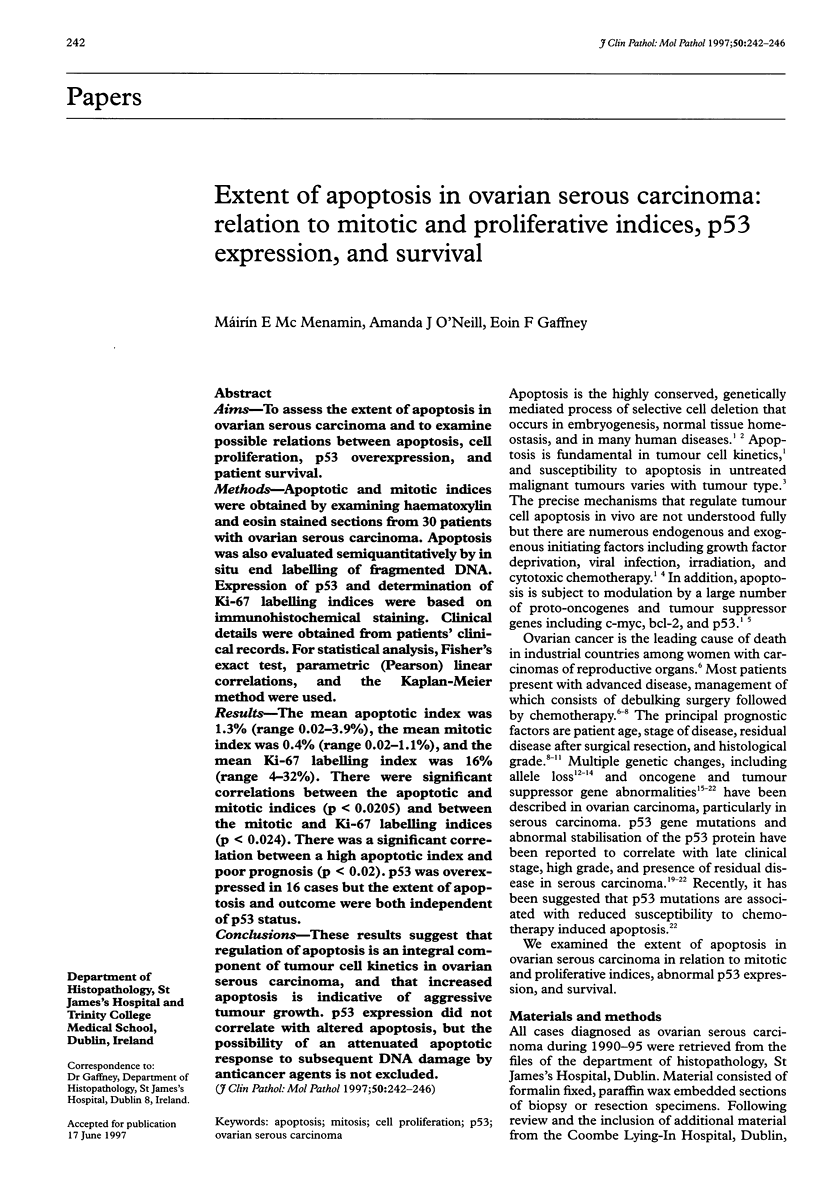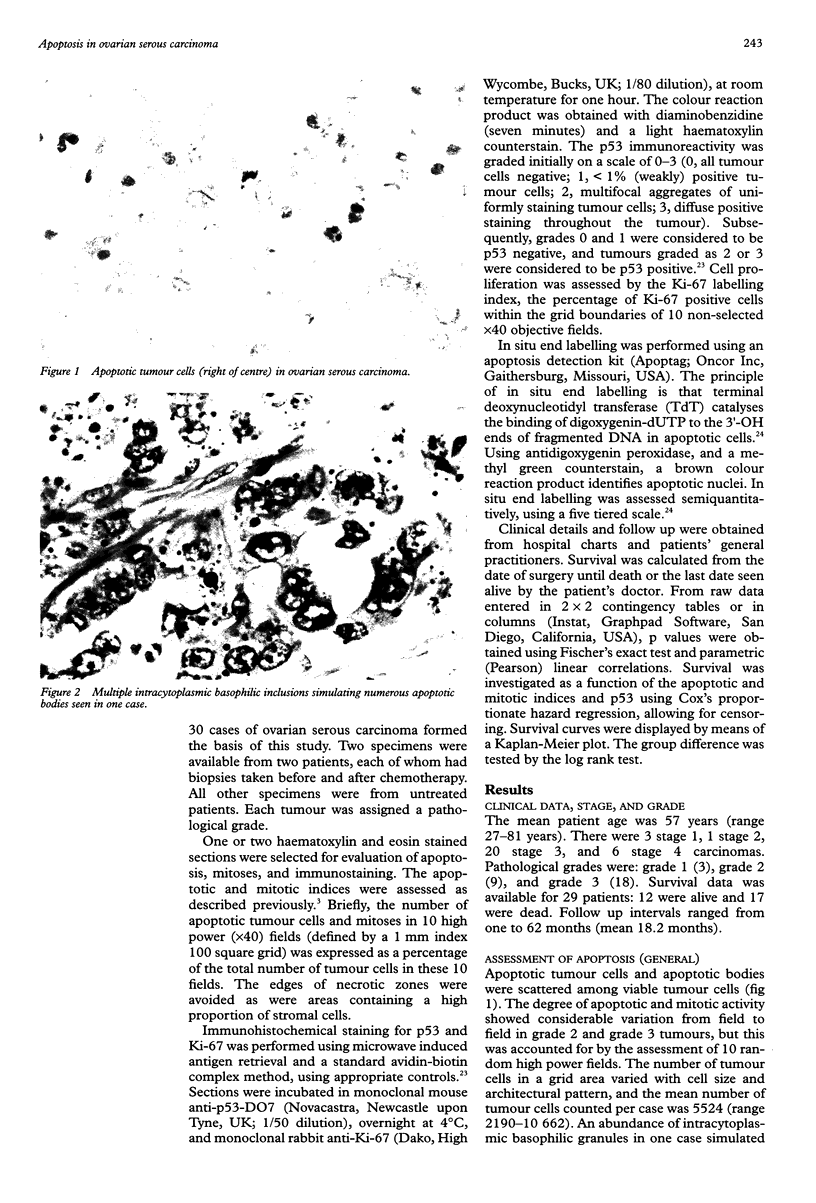Abstract
AIMS: To assess the extent of apoptosis in ovarian serous carcinoma and to examine possible relations between apoptosis, cell proliferation, p53 overexpression, and patient survival. METHODS: Apoptotic and mitotic indices were obtained by examining haematoxylin and eosin stained sections from 30 patients with ovarian serous carcinoma. Apoptosis was also evaluated semiquantitatively by in situ end labelling of fragmented DNA. Expression of p53 and determination of Ki-67 labelling indices were based on immunohistochemical staining. Clinical details were obtained from patients' clinical records. For statistical analysis, Fisher's exact test, parametric (Pearson) linear correlations, and the Kaplan-Meier method were used. RESULTS: The mean apoptotic index was 1.3% (range 0.02-3.9%), the mean mitotic index was 0.4% (range 0.02-1.1%), and the mean Ki-67 labelling index was 16% (range 4-32%). There were significant correlations between the apoptotic and mitotic indices (p < 0.0205) and between the mitotic and Ki-67 labelling indices (p < 0.024). There was a significant correlation between a high apoptotic index and poor prognosis (p < 0.02). p53 was overexpressed in 16 cases but the extent of apoptosis and outcome were both independent of p53 status. CONCLUSIONS: These results suggest that regulation of apoptosis is an integral component of tumour cell kinetics in ovarian serous carcinoma, and that increased apoptosis is indicative of aggressive tumour growth. p53 expression did not correlate with altered apoptosis, but the possibility of an attenuated apoptotic response to subsequent DNA damage by anticancer agents is not excluded.
Full text
PDF




Images in this article
Selected References
These references are in PubMed. This may not be the complete list of references from this article.
- Aihara M., Truong L. D., Dunn J. K., Wheeler T. M., Scardino P. T., Thompson T. C. Frequency of apoptotic bodies positively correlates with Gleason grade in prostate cancer. Hum Pathol. 1994 Aug;25(8):797–801. doi: 10.1016/0046-8177(94)90249-6. [DOI] [PubMed] [Google Scholar]
- Ansari B., Coates P. J., Greenstein B. D., Hall P. A. In situ end-labelling detects DNA strand breaks in apoptosis and other physiological and pathological states. J Pathol. 1993 May;170(1):1–8. doi: 10.1002/path.1711700102. [DOI] [PubMed] [Google Scholar]
- Bracey T. S., Miller J. C., Preece A., Paraskeva C. Gamma-radiation-induced apoptosis in human colorectal adenoma and carcinoma cell lines can occur in the absence of wild type p53. Oncogene. 1995 Jun 15;10(12):2391–2396. [PubMed] [Google Scholar]
- Clarke A. R., Sphyris N., Harrison D. J. Apoptosis in vivo and in vitro: conflict or complementarity? Mol Med Today. 1996 May;2(5):189–191. doi: 10.1016/1357-4310(96)88770-3. [DOI] [PubMed] [Google Scholar]
- Diebold J., Baretton G., Felchner M., Meier W., Dopfer K., Schmidt M., Löhrs U. bcl-2 expression, p53 accumulation, and apoptosis in ovarian carcinomas. Am J Clin Pathol. 1996 Mar;105(3):341–349. doi: 10.1093/ajcp/105.3.341. [DOI] [PubMed] [Google Scholar]
- Eliopoulos A. G., Kerr D. J., Herod J., Hodgkins L., Krajewski S., Reed J. C., Young L. S. The control of apoptosis and drug resistance in ovarian cancer: influence of p53 and Bcl-2. Oncogene. 1995 Oct 5;11(7):1217–1228. [PubMed] [Google Scholar]
- Forrester K., Lupold S. E., Ott V. L., Chay C. H., Band V., Wang X. W., Harris C. C. Effects of p53 mutants on wild-type p53-mediated transactivation are cell type dependent. Oncogene. 1995 Jun 1;10(11):2103–2111. [PubMed] [Google Scholar]
- Foulkes W. D., Ragoussis J., Stamp G. W., Allan G. J., Trowsdale J. Frequent loss of heterozygosity on chromosome 6 in human ovarian carcinoma. Br J Cancer. 1993 Mar;67(3):551–559. doi: 10.1038/bjc.1993.101. [DOI] [PMC free article] [PubMed] [Google Scholar]
- Gaffney E. F., O'Neill A. J., Staunton M. J. In situ end-labelling, light microscopic assessment and ultrastructure of apoptosis in lung carcinoma. J Clin Pathol. 1995 Nov;48(11):1017–1021. doi: 10.1136/jcp.48.11.1017. [DOI] [PMC free article] [PubMed] [Google Scholar]
- Henriksen R., Wilander E., Oberg K. Expression and prognostic significance of Bcl-2 in ovarian tumours. Br J Cancer. 1995 Nov;72(5):1324–1329. doi: 10.1038/bjc.1995.509. [DOI] [PMC free article] [PubMed] [Google Scholar]
- Herod J. J., Eliopoulos A. G., Warwick J., Niedobitek G., Young L. S., Kerr D. J. The prognostic significance of Bcl-2 and p53 expression in ovarian carcinoma. Cancer Res. 1996 May 1;56(9):2178–2184. [PubMed] [Google Scholar]
- Hickman J. A. Apoptosis induced by anticancer drugs. Cancer Metastasis Rev. 1992 Sep;11(2):121–139. doi: 10.1007/BF00048059. [DOI] [PubMed] [Google Scholar]
- Hoffman B., Liebermann D. A. Molecular controls of apoptosis: differentiation/growth arrest primary response genes, proto-oncogenes, and tumor suppressor genes as positive & negative modulators. Oncogene. 1994 Jul;9(7):1807–1812. [PubMed] [Google Scholar]
- Hollowood K., Macartney J. C. Reduced apoptotic cell death in follicular lymphoma. J Pathol. 1991 Apr;163(4):337–342. doi: 10.1002/path.1711630411. [DOI] [PubMed] [Google Scholar]
- Kerr J. F., Winterford C. M., Harmon B. V. Apoptosis. Its significance in cancer and cancer therapy. Cancer. 1994 Apr 15;73(8):2013–2026. doi: 10.1002/1097-0142(19940415)73:8<2013::aid-cncr2820730802>3.0.co;2-j. [DOI] [PubMed] [Google Scholar]
- Kiechle-Schwarz M., Bauknecht T., Wienker T., Walz L., Pfleiderer A. Loss of constitutional heterozygosity on chromosome 11p in human ovarian cancer. Positive correlation with grade of differentiation. Cancer. 1993 Oct 15;72(8):2423–2432. doi: 10.1002/1097-0142(19931015)72:8<2423::aid-cncr2820720821>3.0.co;2-p. [DOI] [PubMed] [Google Scholar]
- Klemi P. J., Pylkkänen L., Kiilholma P., Kurvinen K., Joensuu H. p53 protein detected by immunohistochemistry as a prognostic factor in patients with epithelial ovarian carcinoma. Cancer. 1995 Oct 1;76(7):1201–1208. doi: 10.1002/1097-0142(19951001)76:7<1201::aid-cncr2820760716>3.0.co;2-l. [DOI] [PubMed] [Google Scholar]
- Leoncini L., Del Vecchio M. T., Megha T., Barbini P., Galieni P., Pileri S., Sabattini E., Gherlinzoni F., Tosi P., Kraft R. Correlations between apoptotic and proliferative indices in malignant non-Hodgkin's lymphomas. Am J Pathol. 1993 Mar;142(3):755–763. [PMC free article] [PubMed] [Google Scholar]
- Levesque M. A., Katsaros D., Yu H., Zola P., Sismondi P., Giardina G., Diamandis E. P. Mutant p53 protein overexpression is associated with poor outcome in patients with well or moderately differentiated ovarian carcinoma. Cancer. 1995 Mar 15;75(6):1327–1338. doi: 10.1002/1097-0142(19950315)75:6<1327::aid-cncr2820750615>3.0.co;2-p. [DOI] [PubMed] [Google Scholar]
- Levine E. L., Renehan A., Gossiel R., Davidson S. E., Roberts S. A., Chadwick C., Wilks D. P., Potten C. S., Hendry J. H., Hunter R. D. Apoptosis, intrinsic radiosensitivity and prediction of radiotherapy response in cervical carcinoma. Radiother Oncol. 1995 Oct;37(1):1–9. doi: 10.1016/0167-8140(95)01622-n. [DOI] [PubMed] [Google Scholar]
- Lipponen P. K., Aaltomaa S. Apoptosis in bladder cancer as related to standard prognostic factors and prognosis. J Pathol. 1994 Aug;173(4):333–339. doi: 10.1002/path.1711730408. [DOI] [PubMed] [Google Scholar]
- McGahon A., Bissonnette R., Schmitt M., Cotter K. M., Green D. R., Cotter T. G. BCR-ABL maintains resistance of chronic myelogenous leukemia cells to apoptotic cell death. Blood. 1994 Mar 1;83(5):1179–1187. [PubMed] [Google Scholar]
- McGuire W. P., Hoskins W. J., Brady M. F., Kucera P. R., Partridge E. E., Look K. Y., Clarke-Pearson D. L., Davidson M. Cyclophosphamide and cisplatin compared with paclitaxel and cisplatin in patients with stage III and stage IV ovarian cancer. N Engl J Med. 1996 Jan 4;334(1):1–6. doi: 10.1056/NEJM199601043340101. [DOI] [PubMed] [Google Scholar]
- McManus D. T., Murphy M., Arthur K., Hamilton P. W., Russell S. E., Toner P. G. p53 mutation, allele loss on chromosome 17p, and DNA content in ovarian carcinoma. J Pathol. 1996 Jun;179(2):177–182. doi: 10.1002/(SICI)1096-9896(199606)179:2<177::AID-PATH561>3.0.CO;2-2. [DOI] [PubMed] [Google Scholar]
- McManus D. T., Yap E. P., Maxwell P., Russell S. E., Toner P. G., McGee J. O. p53 expression, mutation, and allelic deletion in ovarian cancer. J Pathol. 1994 Nov;174(3):159–168. doi: 10.1002/path.1711740304. [DOI] [PubMed] [Google Scholar]
- Meyn R. E., Stephens L. C., Ang K. K., Hunter N. R., Brock W. A., Milas L., Peters L. J. Heterogeneity in the development of apoptosis in irradiated murine tumours of different histologies. Int J Radiat Biol. 1993 Nov;64(5):583–591. doi: 10.1080/09553009314551801. [DOI] [PubMed] [Google Scholar]
- O'Neill A. J., Staunton M. J., Gaffney E. F. Apoptosis occurs independently of bcl-2 and p53 over-expression in non-small cell lung carcinoma. Histopathology. 1996 Jul;29(1):45–50. doi: 10.1046/j.1365-2559.1996.d01-478.x. [DOI] [PubMed] [Google Scholar]
- Ozols R. F., Garvin A. J., Costa J., Simon R. M., Young R. C. Advanced ovarian cancer: correlation of histologic grade with response to therapy and survival. Cancer. 1980 Feb;45(3):572–581. doi: 10.1002/1097-0142(19800201)45:3<572::aid-cncr2820450325>3.0.co;2-3. [DOI] [PubMed] [Google Scholar]
- Partridge E. E., Phillips J. L., Menck H. R. The National Cancer Data Base report on ovarian cancer treatment in United States hospitals. Cancer. 1996 Nov 15;78(10):2236–2246. doi: 10.1002/(sici)1097-0142(19961115)78:10<2236::aid-cncr28>3.0.co;2-z. [DOI] [PubMed] [Google Scholar]
- Perego P., Giarola M., Righetti S. C., Supino R., Caserini C., Delia D., Pierotti M. A., Miyashita T., Reed J. C., Zunino F. Association between cisplatin resistance and mutation of p53 gene and reduced bax expression in ovarian carcinoma cell systems. Cancer Res. 1996 Feb 1;56(3):556–562. [PubMed] [Google Scholar]
- Potten C. S. What is an apoptotic index measuring? A commentary. Br J Cancer. 1996 Dec;74(11):1743–1748. doi: 10.1038/bjc.1996.624. [DOI] [PMC free article] [PubMed] [Google Scholar]
- Smets L. A. Programmed cell death (apoptosis) and response to anti-cancer drugs. Anticancer Drugs. 1994 Feb;5(1):3–9. doi: 10.1097/00001813-199402000-00001. [DOI] [PubMed] [Google Scholar]
- Solary E., Dubrez L., Eymin B. The role of apoptosis in the pathogenesis and treatment of diseases. Eur Respir J. 1996 Jun;9(6):1293–1305. doi: 10.1183/09031936.96.09061293. [DOI] [PubMed] [Google Scholar]
- Sorbe B., Frankendal B., Veress B. Importance of histologic grading in the prognosis of epithelial ovarian carcinoma. Obstet Gynecol. 1982 May;59(5):576–582. [PubMed] [Google Scholar]
- Swenerton K. D., Hislop T. G., Spinelli J., LeRiche J. C., Yang N., Boyes D. A. Ovarian carcinoma: a multivariate analysis of prognostic factors. Obstet Gynecol. 1985 Feb;65(2):264–270. [PubMed] [Google Scholar]
- Tashiro H., Miyazaki K., Okamura H., Iwai A., Fukumoto M. c-myc over-expression in human primary ovarian tumours: its relevance to tumour progression. Int J Cancer. 1992 Mar 12;50(5):828–833. doi: 10.1002/ijc.2910500528. [DOI] [PubMed] [Google Scholar]
- Todd D., Yang G., Brown R. W., Cao J., D'Agati V., Thompson T. S., Truong L. D. Apoptosis in renal cell carcinoma: detection by in situ end-labeling of fragmented DNA and correlation with other prognostic factors. Hum Pathol. 1996 Oct;27(10):1012–1017. doi: 10.1016/s0046-8177(96)90276-2. [DOI] [PubMed] [Google Scholar]
- Wyllie A. H. Apoptosis and the regulation of cell numbers in normal and neoplastic tissues: an overview. Cancer Metastasis Rev. 1992 Sep;11(2):95–103. doi: 10.1007/BF00048057. [DOI] [PubMed] [Google Scholar]
- van Dam P. A., Vergote I. B., Lowe D. G., Watson J. V., van Damme P., van der Auwera J. C., Shepherd J. H. Expression of c-erbB-2, c-myc, and c-ras oncoproteins, insulin-like growth factor receptor I, and epidermal growth factor receptor in ovarian carcinoma. J Clin Pathol. 1994 Oct;47(10):914–919. doi: 10.1136/jcp.47.10.914. [DOI] [PMC free article] [PubMed] [Google Scholar]






